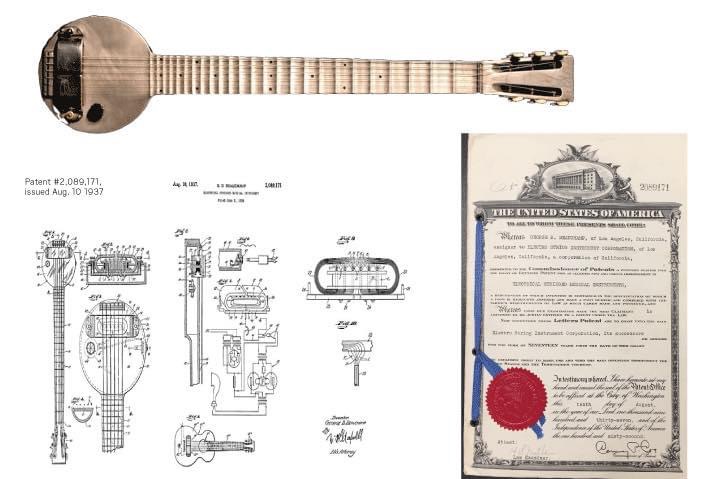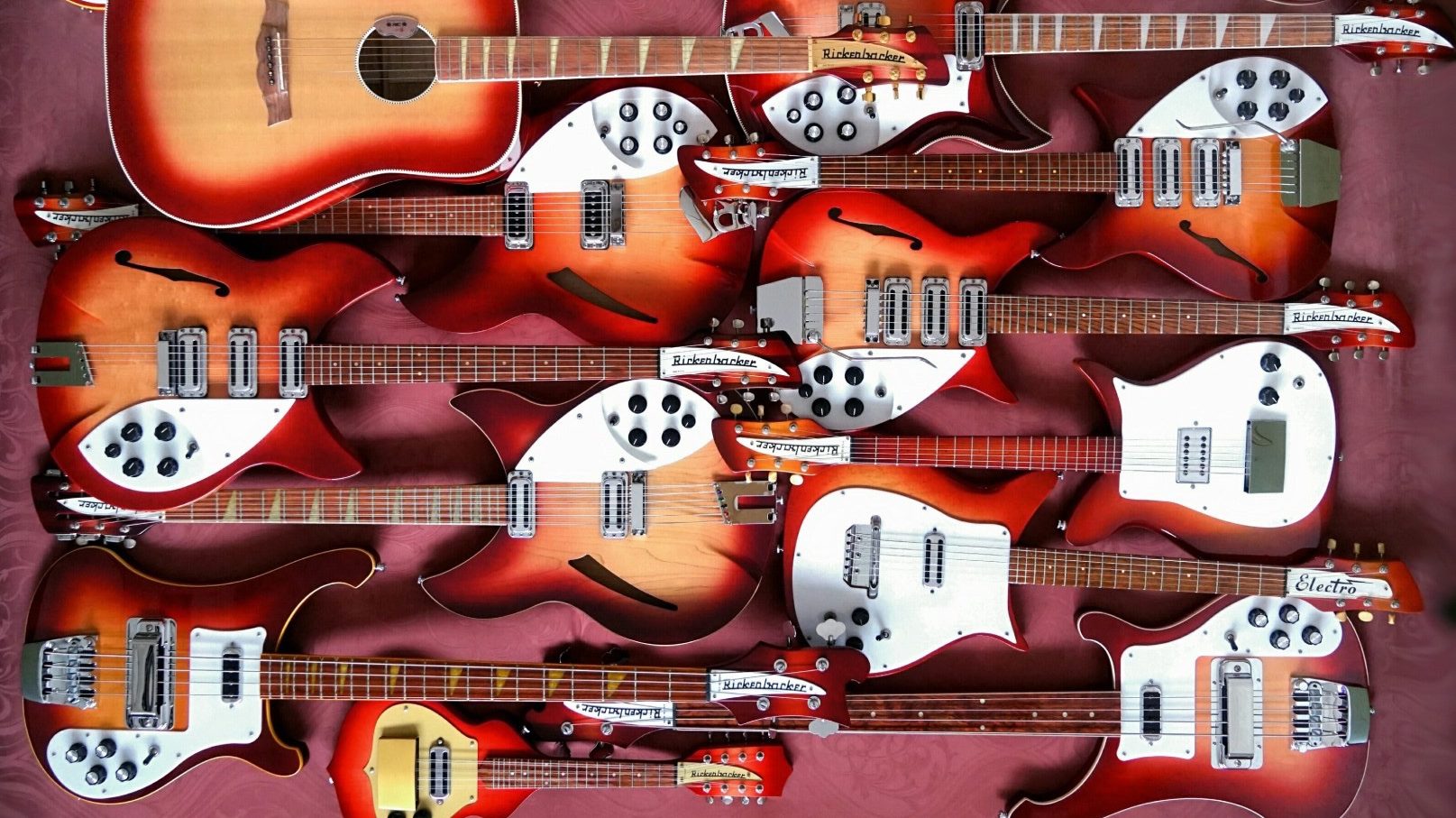91st Anniversary of the Electric Guitar and 85th Anniversary of It’s Patent – Rickenbacker Electric Guitars
On Aug. 10, 1937, the U.S. Patent and Trademark Office issued Electro String Instrument Corp. a patent for electrical stringed musical instruments. The Electro String company, now known as Rickenbacker International Corp., began making the electrical guitar in 1931 (Technically the 91st anniversary of the electric guitar) and is based in Santa Ana.

The new sound of the electric guitar was a dramatic shift from the strum of the acoustic guitars that had been played for centuries. For the first time the guitar could hold its own in a band and it revolutionized the sound of popular music for decades to follow.
The first Rickenbacker electric guitars were lap steel guitars called the Electro Hawaiian, but they were known as “frying pans” because they were made out of aluminum and had a round, pan-shaped body. They were about 3 feet long.
The original:
The first electric guitar was designed in 1931 by guitarist George Beauchamp (pronounced Beechum), to amplify the lap steel guitar he used to play Hawaiian music through a radio. The prototype hangs in the Rickenbacker office. It was made from wood from a backyard fence, and in a way the company hasn’t strayed far from that backyard. In the world of globalization and cheap foreign labor, Rickenbacker has stayed close to where it started. The headquarters were in Los Angeles before moving to Orange County in 1953.
Ace of a name:
Beauchamp came up with the means to amplify music and collaborated with a toolmaker, Adolph Rickenbacker, to create a company they called Electro String. They called the instruments Rickenbackers because Adolph’s second cousin was the famous World War I ace fighter pilot, Eddie Rickenbacker, and the name brought great name recognition.
The key to electrification:
The pickups in the early guitars worked similarly to how a telephone can translate sound waves across electric lines. Instead of a membrane between magnets, as with telephones, the guitar has a string. This minor difference kept Rickenbacker from receiving its patent as soon as the company would have liked. The original patent was filed in the early 1930s and took several revisions to be accepted.
Rock’n on:
The U.S. Patent Office might not have known whether the “frying pan” was electronics or an instrument, but musicians did, and toward the end of the Great Depression, electric guitar companies began to spring up around the nation. The guitars made by Beauchamp and Rickenbacker were on the cutting edge of the electrified instruments. The era also saw the rise of Fender Guitars, which originated in Fullerton as early as 1938. The two companies are linked at the roots since Leo Fender repaired Rickenbacker amps in his radio repair shop, and one of the owners of Fender, Francis C. Hall, bought Electro String in 1953. Hall’s family runs Rickenbacker today.
Francis Hall brought the fierce passion and high standards of quality into the models that found their way to John Lennon in 1964. Rickenbackers were mostly seen in the hands of country musicians until the visibility of having the biggest rock band in the world, the Beatles, gave the company global rock ‘n’ roll recognition.
In describing the Rickenbacker guitar, John Hall, the Rickenbacker chairman and CEO, said, “We’re a lot like a Porsche on a road of Chevys and Toyotas. We have limited supply and high quality, but are not a boutique type, like Rolls-Royce.”
It’s a good analogy considering the long and winding road the company has traveled for 91-plus years.
The Beatles in 1964 playing Rickenbacker guitars.
Below:
John Hall, Rickenbacker International Corp. CEO, stands where cut boards are delivered daily to make the more than 25 models of Rickenbacker guitars.
Trademarked shape:
The shapes of Rickenbacker guitar heads and bodies are protected by trademark. Knockoffs are a problem, particularly in the Philippines and China, where U.S. trademark rules are more likely to be ignored. But Rickenbacker CEO John Hall said the company couldn’t keep up with the demand in China and doesn’t sell there.
The most popular models are the 4003 bass (left) and the 330 guitar (right). Hall says the company has a two-year back order on the 4003 bass.

On August 10, 1937, the Electro String Corporation was awarded the first-ever electric guitar patent. Invented by G.D. Beauchamp, the instrument was known as the Rickenbacker Frying Pan.
The new sound of the electric guitar was a dramatic shift from the strum of the acoustic guitars that had been played for centuries. For the first time the guitar could hold its own in a band and it revolutionized the sound of popular music for decades to follow.
The first two 12-string Rickenbacker guitar’s went to George Harrison and Roger McGuinn (The Birds) Brilliant strategic move.
Rickenbacker twelve-string guitars were favoured by George Harrison of the Beatles, Roger McGuinn of the Byrds, Pete Townshend of the Who, and Tom Petty. Players of the six-string include John Lennon of the Beatles, John Fogerty of Creedence Clearwater Revival, Paul Weller of the Jam, John Kay of Steppenwolf, Peter Buck of R.E.M., Johnny Marr of the Smiths, and Susanna Hoffs of the Bangles. Players who have used Rickenbacker basses include Paul McCartney of the Beatles, Lemmy Kilmister of Motörhead, Cliff Burton of Metallica, Roger Glover and Glenn Hughes of Deep Purple, Paul Wilson of Snow Patrol, Bruce Foxton of the Jam, Roger Waters of Pink Floyd, James Dean Bradfield of Manic Street Preachers, Phil Lynott of Thin Lizzy, Chris Squire of Yes, Geddy Lee of Rush, Al Cisneros of Sleep and Om, Paul D’Amour of Tool, and Rick James and Kevin Parker of Tame Impala.

